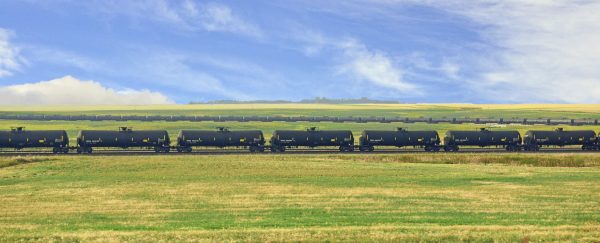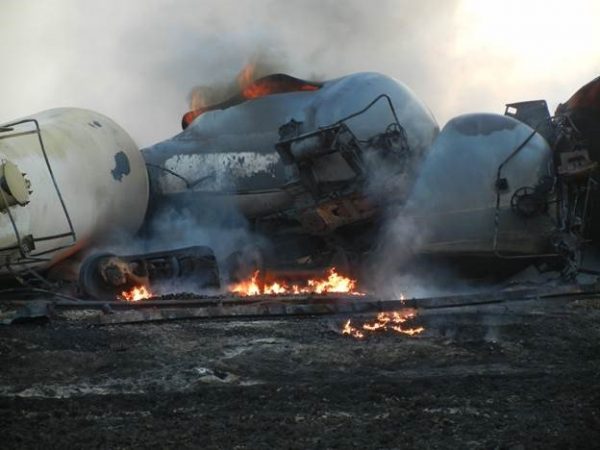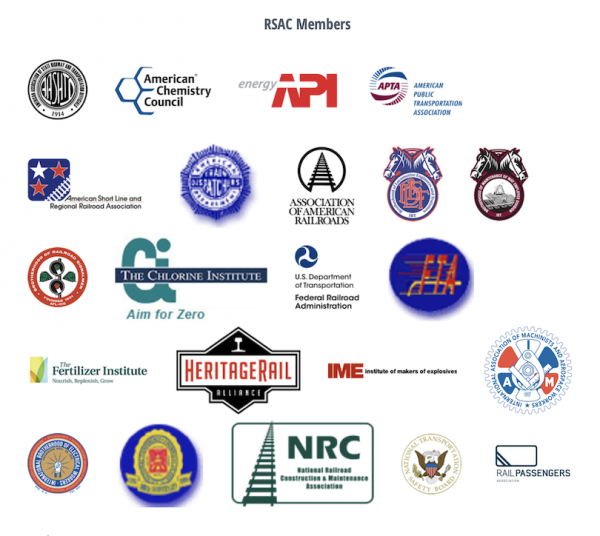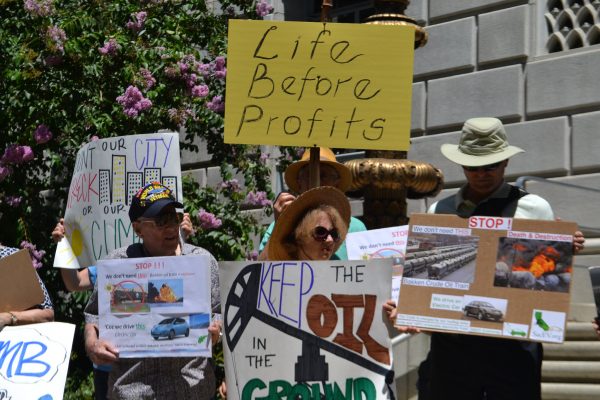By Justin Mikulka, a freelance writer, audio and video producer living in Trumansburg, NY. Originally published at DeSmog Blog
This week, the Trump administration’s Department of Transportation (DOT) withdrew another rail safety recommendation originally proposed during the Obama administration. In the process, the agency made quite clear that it has no plans to further regulate the rail industry, especially the dangerous and continued transportation of oil and ethanol in unsafe tank cars.
The latest proposed rule to be withdrawn would have required two-person crews on trains. Supporters of this rule argue that two-person crews are safer because the job of operating a train is too demanding for one person, new technologies are making the job more complex, and fatigue becomes a more serious issue with only one crew member. Since 2017, the Trump administration has already repealed a regulation requiring modern brakes for oil trains and canceled a plan requiring train operators to be tested for sleep apnea.
In announcing this decision, the DOT’s Federal Railroad Administration (FRA) stated it was “providing notice of its affirmative decision that no regulation of train crew staffing is necessary or appropriate for railroad operations to be conducted safely at this time.”
Buried on page 21 of the 25 page document explaining the decision, the FRA spells out the broader department attitude toward rail safety:
“DOT’s approach to achieving safety improvements begins with a focus on removing unnecessary barriers and issuing voluntary guidance, rather than regulations that could stifle innovation.”
As we’ve documented on DeSmog before, that translates to removing existing safety requirements and allowing the rail industry to volunteer when and how to improve safety. When the head of the FRA is a former rail company CEO, corporate capture of the U.S.regulatory system should come as no surprise. The rail industry’s main opposition to this rule is that it will increase costs while claiming it will not improve safety. This is the same basic argument used to support the industry’s opposition to other safety regulations.
FRA Overriding States’ Rights to Regulate Rail Safety

North Dakota oil train. Credit: Jerry and Pat Donaho, CC BY-ND2.0
In addition, this FRA memo contained several statements clarifying that not only will the agency back off of regulating rail safety, it also will use the power of “pre-emption” to make sure states can’t fill the resulting regulatory gaps either.
As we have explained before, rail companies are essentially only accountable to federal regulators (should they choose to regulate) due to a legal doctrine known as “pre-emption,” which exempts interstate rail companies from observing local or state laws where they operate.
This is important in this instance because several states have passed laws regarding train crew staffing, and other states are considering such regulation. The FRA notes in detail these state efforts and then says that its decision not to regulate crew size preempts any such rules at the state level:
“FRA intends this notice of withdrawal to cover the same subject matter as the state laws regulating crew size and therefore expects it will have preemptive effect.”
The document goes on to cite Supreme Court case law in an attempt to justify this approach and then reiterates the point in its final line, saying that “no regulation of train crew staffing is appropriate and that FRA intends to negatively preempt any state laws concerning that subject matter.”

On December 31, 2013, part of the tank car pileup and residual fire resulting from the train collision near Casselton, North Dakota. Credit: National Transportation Safety Board, public domain
With this document, the FRA likely is setting up a precedent to follow for regulating the volatility and vapor pressure of crude oil transported by rail. DeSmog has covered in detail the issue of oil volatility, which appears to be the key for turning oil trains into “bomb trains,” as rail operators have dubbed them.
The last remaining rail safety proposal on the books from the Obama administration concerns the vapor pressure of oil in rail tank cars, but that was proposed in 2017 and the DOT website lists the status of this proposed rule as “undetermined.”
Meanwhile, the state of Washington has passed a law regulating the vapor pressure of oil for rail transport. This law is being challenged by North Dakota — the source of many of the bomb trains involved in fiery accidents, including the Lac-Mégantic, Canada, disaster that killed 47 people in 2013 and helped inspire the proposed rule requiring two-person crews that the Trump adminstration just withdrew this week.
Based on the FRA’s strategy with the rail staffing rule, expect to see the Trump administration withdraw the proposed regulation on oil vapor pressure and say this move preempts Washington state’s law.
The Lac-Mégantic rail disaster saw the loss of 47 lives but no effective changes to safety regulation. 5 years later, could it happen again?
The latest @CANADALANDCMNS delves into this question and more, featuring Bruce Campbell, author of The Lac-Mégantic Rail Disaster.
— James Lorimer & Co (@LorimerBooks) 29 May 2019
A Case Study in the Corporate Capture of American Regulation
The FRA’s decision to withdraw the train crew rule is a great case study of a failed regulatory system in America.
The public is supposed to have a say in the regulatory process via the public comment process. In this case, approximately 1,500 comments supported the regulation — including comments from members of Congress — and 39 opposed it. The opposition highlighted by the DOT was from rail lobbying groups the Association of American Railroads and the American Short Line and Regional Railroad Association. While the public can have its say, it may not have any impact in the current regulatory process.
The FRAdocument also notes that the Railroad Safety Advisory Committee (RSAC reviewed the issue but “was unable to reach consensus on any recommendation.” RSAC was established by the FRA but is dominated by industry members, including the Association of American Railroads and the American Petroleum Institute, the latter of which is the nation’s largest oil lobby and has repeatedly misrepresented basic facts about crude oil volatility and rail transport.
This advisory committee doesn’t have the membership to make an independent recommendation that goes against its members’ interests.

Screen shot of RSAC members from the Federal Railroad Administration website.
Another key point in the FRA’s withdrawal decision is that it claims there is no evidence that two-person crews are safer than single-person crews on trains. The agency cites industry-funded studies, which make this claim and say the regulation would “greatly reduce U.S.railroads’ ability to control operating costs.” Because the FRAitself does not collect data on the use and safety of single-person crews versus two-person crews, it can’t provide any information one way or the other.
The one clear scenario where two-person crews increase safety is in accident situations, a point made by many commenters and acknowledged by the FRA. In the 2013 BNSF oil train derailment and explosion in Casselton, North Dakota, crew members were able to separate many of the oil tank cars from the rest of the train, likely preventing a much larger oil spill and fire (which were still large). The FRA argues that while this is true, the same role can be played by first responders:
“While FRA acknowledges the BNSF key train crew performed well, potentially saving each other’s lives, it is possible that one properly trained crewmember, technology, and/or additional railroad emergency planning could have achieved similar mitigating actions.”
Despite making this assertion, the agency provided no evidence of how these alternatives are possible. In the case of oil train accidents, there are no examples of first responders arriving in time to do anything other than back away from the often-explosive trains and let them burn.
In the case of Casselton, the city fire chief Tim McLean said, “I’m glad the crew made it out of the engine because I don’t know if we would have been able to get in there and get them.” Casselton’s first responders were working to evacuate the city, not deal with the exploding train cars.
‘Keeping their Profits’
Two years ago, I wrote about the Trump administration’s and Congress’s plans to de-regulate the oil-by-rail industry, and featured a quote from Rep. Bill Shuster, who championed finding ways to “allow the railroad industry to keep more of their profits” at a hearing on pipeline and rail regulations.
With rail companies now comfortably positioned to self-regulate under the Trump administration, the industry can continue its long (and, at times, bloody) history of putting profits over safety. The Department of Transportation’s latest move makes this approach official government policy.
On July 9, 2014, 350 Sacramento joins California Assemblymember Roger Dickinson for an oil-by-rail protest at the Federal Railroad Administration. Credit: Stand, CC BY 2.0


Mile long trains manned by one crew member are accidents waiting to happen. This will kill and maim people. Commercial airliners have a two-person cockpit crews for a good reason. An improperly tied down train by the sole engineer killed 43 in Canada. A conductor not calling out signals and signs contributed to killing three in Amtrak’s 2017 Talgo crash onto I-5 in Washington State. A single engineer is subject to fatigue and distraction with no one to snap them out of it. A second crew member can check for problems, set brakes, and switch tracks while the engineer stays on board the running locomotive. This is solely a safety issue.
Each new death will be on the corporations and regulators pushing this to increase their profits. If promulgated, they deserve jail time for manslaughter with the next inevitable death.
If the two-driver rule is being withdrawn, then I see one major reason for this. Those companies must be planning on using autonomous trains down the track, so to say. The driver would then become more a monitor than a driver and perhaps be done away with altogether due to the fact that the job would be too fatiguing for a single driver. This is happening elsewhere. Here in Oz, the Rio Tito Group has been using autonomous trains since last July to transport iron ore using its “AutoHaul” system. Last I heard, they were running about three dozen of these robot trains a day. Here is a short clip showing the initial run-
https://www.youtube.com/watch?v=fSMl1O9xxp4
Of course there are two major differences between Oz and the US with the use of these trains if the US brings them in. The ones in Oz go through the Pilbara and from that film clip, you can see that it is pretty barren country people-wise. An autonomous train in the US would run through a lot of small towns and perhaps cities. The ones in the US would also be transporting oil and that film clip from Casselton, North Dakota shows what happens when they go bump. The ones in Oz are use for transporting iron ore and after intense internet research, I have found that there is no situation in which they will ever explode in a train crash/derailment.
I think you’re right about the a plan to replace human drivers with autonomous trains monitored by a human. I didn’t realize human train drivers [R.R. engineers?] were so very expensive that using one instead of two and eventually one ‘monitor’ instead of one driver were such a great savings. Are the railroad companies going to be indemnified against accident risks in some other pending deregulations? Maybe they could contract out for the train-monitors and hang any accident risk on fly-by-night contracting firms and any train-monitor who is so lucky as to survive an accident. What of the rails? I road trains cross-country last year and a lot of the ride was wavy and bumpy. How smart are the autonomous trains?
How smart are the autonomous trains?
Smart enough to do precisely what management tells them to do.
“Because the FRAitself does not collect data on the use and safety of single-person crews versus two-person crews, it can’t provide any information one way or the other.”
Other countries might have studied this question.
This sounds like what happened with Boeing and the FAA. Now all we need is for the railroad CEO’s to have backgrounds in the military-industrial complex.
I’m waiting for 15-20 cars full of dilute bitumen to derail & explode directly across from Manhattan. There’re ALWAYS bomb trains shunted alongside AMTRAK’s NE Corridor where 130mph Acela are passing 80-90mph trains on decrepit infrastructure. Just waiting to happen, like any shithole kleptocracy.
https://www.google.com/amp/s/amp.northjersey.com/amp/1492902002
https://static01.nyt.com/images/2015/05/14/us/sub14TRAIN/sub14TRAIN-superJumbo.jpg?quality=90&auto=webp
“I’m waiting for 15-20 cars full of dilute bitumen to derail & explode directly across from Manhattan.”
Hopefully next to a Trump property. Is this rule actually going to save the train companies money? How expensive are these accidents? Perhaps the real question is how many CEO bonuses can be milked from this rule.
Well, we’ve been TOLD, there’ll be another (fracked PA CNG fired?) power plant going into North Bergen, we hear trains across the Hudson all night. Heavy cars, here, usually means tankers, heading to NJ refineries? I was in Huston with Texas Eastern’s GREAT old inspection boss when they blew up part of Edison, NJ. A failed tie-in weld, cracked by a backhoe or something, in cold weather. They had windows breaking up here, in the UWS? A 36″ line, rolled at Bethlehem/ Steelton, or some damn thing? Shit happens? Don’t live in a valley!
Score one for Warren Buffet…
One of the more irritating indirect developments from this is that people can now say that 1) we are still reliant on oil 2) that oil needs to be transported 3) trains clearly aren’t safe as a means of transportation 4) therefore pipelines are a better idea. It’s gussied-up NIMBYism because pipelines usually don’t travel through highly populated areas and only destroy the local environment for decades/centuries upon leaking rather than killing people directly. Obviously I’m all for tanker cars not exploding in the middle of communities, but I’m also not a great fan of the long-term loss of fresh water and the exporting of negative consequences to poor/rural/indigenous people.
This is similar to this morning’s glyphosate issue. Once again, where is Congress? The administration enforces the laws but Congress is supposed to oversee. To busy fretting over Mueller?
Where is Congress? Gathering campaign contributions everyone and assuring a lucrative job for later. The administration enforces the laws and Congress oversees that process with the same careful attention to the public good we enjoy from the administration’s efforts. Mueller is purely for entertainment.
It isn’t bad enough that we face multiple threats to our future, endless wars, nuclear war, Climate Chaos, resource depletion, crumbling infrastructure … Neoliberalism seems intent on constructing as much fragility as possible into our already fragile Society.
And determining when we go to war…..Right?
The Legislature, (especiallyTHIS Executive), Judiciary & Media are at work, as most of us knew by draft age. Trump is the Boogieman this time, like Obama & Shrub before him. He’s distracting the 10% Pussyhat hordes as Barack did with CNBC/ FOX’s totally spontaneous baggers. Poisoned air, water, food: RussiaRussiaRussia; National Healthcare including longterm homecare & price/quality control on meds: RussiaRussiaRussia; Run-away global warming, worse than anticipated: RussiaRussiaRussia; Police shooting down folks in their motor vehicles or home, at WILL, without repercussions You guessed it: RussiaRussiaRussia! Thi IS their job!
https://www.gq.com/story/democratic-leadership-base